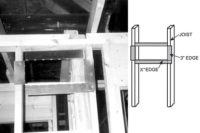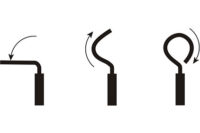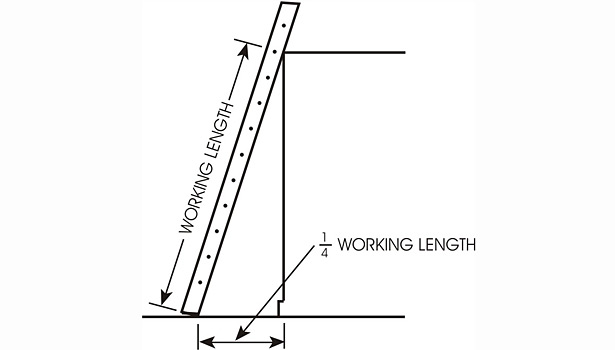HVACR Tips: Ladder Safety
Set Your Ladder at the Proper Angle, Make Sure It Is Secure

Figure 1. The distance of the base from the wall should be ¼ of the working length.

Figure 2. Three ways to secure a ladder so it won‘t slip.


How many times have you used an oil drum, a bucket, a box, or a chair to step on because a ladder wasn‘t handy? It‘s pretty dumb, but we‘ve all done it at one time or another. And most of us have gotten away with it. But I know of some broken arms and hands that resulted from it — and even a broken back. If you‘ve done it and gotten away with it, it means you won the gamble. But think of what you bet. You bet a few minutes of time against a loss of $100,000 of income — plus suffering for you and your family.
Keep Control
The biggest danger when carrying ladders is hitting someone or something. You are not going to be popular if you knock over a homeowner’s favorite lamp or break a technician’s test instruments. When possible, carry a ladder vertically and against your chest. Be aware of electrical wires or other overhead obstacles. A long ladder should be carried horizontally by two workers — one on each end — so that it can be controlled at both ends. If you must carry a ladder in a horizontal position by yourself, be very aware of the position of both ends of the ladder.
Damaged Ladders
Ladders must be in good condition. A broken rung can cause a fall. Slits in the rail can result in a broken ladder and a fall. Return a ladder to the shop if any part is broken or cracked or not working properly. Never use a ladder that is painted. The paint can hide splits and cracks.
You are not doing your employer a favor by leaving a damaged ladder on the job. An accident caused by a damaged ladder can lead to fines from the Occupational Safety and Health Administration (OSHA). Any accidents on the job lead to increased workers’ compensation insurance costs.
Get the Right Spot
Choose a safe spot to set up a ladder. Don’t set up next to a hoisting area or in a heavy traffic area. Keep the area clear of debris at both the top and bottom.
Get the Right Angle
You risk a fall if you try to climb a ladder that is set at too steep an angle. The closer a ladder is to straight up and down, the easier it is to fall off. But if the angle isn‘t steep enough, the bottom could slip out and cause a fall.
The standard rule for the ladder angle (also the OSHA requirement) is the 1 to 4 rule. This means that for every 4 feet of ladder being used (the working length), the bottom of the ladder should be set 1 foot out from the wall (Figure 1). This is about a 75 degree angle.
An easy way to determine the amount to set out from the wall is to count the rungs being used. Since the rungs are 1 foot apart, this gives you the working length of the ladder. The bottom of the ladder should be set out one-fourth of this length. For example, if you are using 12 rungs, the bottom of the ladder should be three feet out from the wall.
Get Off Safely
You risk another fall when you step off the ladder onto the roof. To avoid this, the ladder should extend at least three feet above the roof (Figure 2). This gives you something to hold onto as you step off the ladder (as long as the ladder is secure, as described below). If the ladder does not extend three feet, OSHA requires that it be secured to a “rigid support” such as a grab rail. A grab rail should be constructed in any case if the ladder will be in place for some months.
No Tipping or Slipping
Holding onto the ladder when stepping off is no help if the ladder slips. Therefore, the top of the ladder should be tied off (Figure 2).
In addition to tying a ladder at the top, be aware of the base of the ladder. If a ladder is on solid ground and if it has safety feet (Figure 1), there is little danger of the bottom moving. But if the ground is soft, the leg could sink into the ground and the ladder will tip. Always put a board under ladder legs if the ground appears soft. If a leg sinks when you are on the ladder, it’s probably hospital time. If the base of the ladder could slip, block the ladder: Nail a cleat behind the leg (Figure 2) or tie it off to the building (Figure 2).
Excerpted and reprinted from Top 100 HVAC/R Tips by Leo A. Meyer, one of the books in the Indoor Environment Technician’s Library series published by LAMA Books.
Publication date: 6/10/2013











